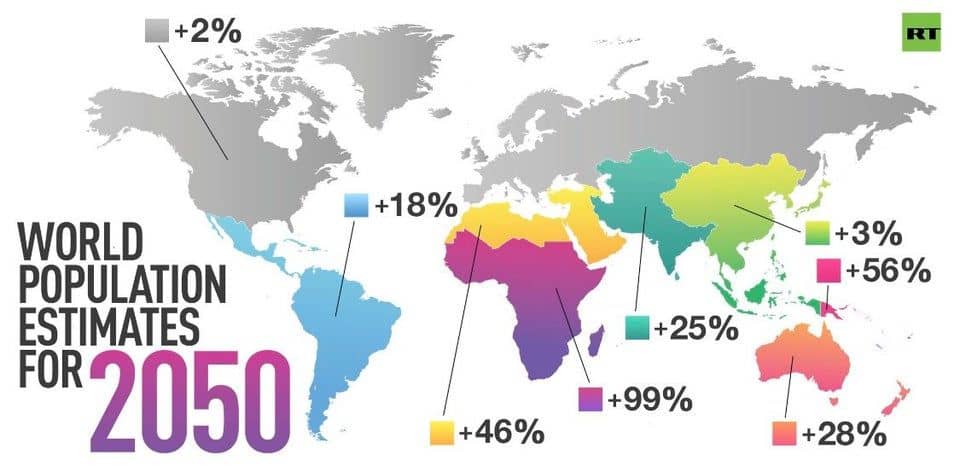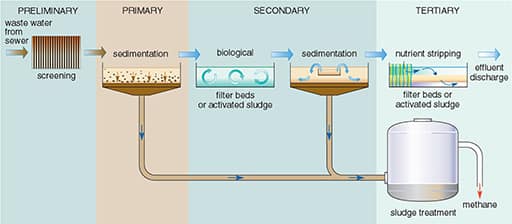We’re not treating wastewater; we’re wasting energy to destroy larger amounts of energy!
Today, I’ll tell you why, how, and what we shall do about it.
(This deep dive is part of my focus on the Water-Energy Nexus)

Table of contents
- How much energy do we spend on Wastewater Treatment?
- What are we using energy for in Wastewater Treatment?
- What is an organic compound?
- What’s the Energy Content of Municipal Wastewater?
- How to capture Municipal Wastewater’s Energy?
- Three emerging technologies that leverage wastewater’s power
- Bonus Energy: Wastewater’s Heat!
How much energy do we spend on Wastewater Treatment?
Treating municipal wastewater represents 3 to 5% of the Global Electricity Consumption. Which makes for about 1’000 Tera Watt Hour of electricity every year, the equivalent of the production of 200 nuclear power reactors.
According to the latest estimates, the World treats about half of its wastewater. This is way up from the previous figure of 20%, but there’s still a way to go!

This means that by the time we meet the United Nation’s Sustainable Development Goal number six, we will need twice much energy to treat wastewater.
Then, you have to add to this that the World’s population is still growing: we shall be 3 billion more humans on earth by 2050.

And all in all, that means that by 2050 we will need about 520 nuclear power reactors to feed our wastewater treatment plants. That’s more than the World’s installed base, plus all the currently planned ones.
(Still, we’re only talking of municipal wastewater, and not even touching on the carbon emissions of all these processes.)
I guess you can feel it: we have a problem.

But let’s pause here for a second:
What are we using energy for in Wastewater Treatment?
Let me recap what a wastewater treatment plant does in 20 seconds. First, it sorts out everything that floats or sinks in a first physical step. That’s called primary treatment.
Then, it takes on organic compounds. That’s secondary treatment.
It then often goes to a filtration step that takes on phosphates, nitrates, and remaining suspended solids, which would be tertiary treatment.

And then, in some places, it gets further treated in a quaternary treatment to remove emerging contaminants.
That’s not our topic for today, but come tell me if you’d like me to go deeper into wastewater treatment in a next release!
The gluttonous Secondary Treatment
Back to our question: what are we using our energy for? Well, most of it, 50 to 70% is spent in secondary treatment, to remove the organic compounds I mentioned.
Which leads to the logical follow-up question:
What is an organic compound?
Well, by definition, it’s anything that contains carbon-hydrogen bonds. So it can be, for instance, pesticides, greases, protein, or sugar.
The problem with these organic compounds is that they will be oxidized into something else when released into the environment, and this oxidation requires oxygen – sounds pretty straightforward, right?
This means that the receiving environment will see its oxygen being sucked, which leads, of course, to critical damages to aquatic life and vegetation.
How to measure organic compounds?
You can measure that with two tools: the biological oxidation demand, which is the oxygen micro-organism will need to break down the pollutants, and chemical oxidation demand, which is the same, but with chemicals.
On average, you, me, and every human on earth produce about 60 to 120 grams of chemical oxygen demand every day.
With 10 billion humans on earth by 2050, that’s one million tons of chemical oxygen demand every day.
But here’s the trick, that’s not pollution. That’s energy.

Let me explain:
Let’s Compare Coal, Wood and… Glucose
This is Coal: C240-H90-O4-N-S

You recognize the C-H bond, so it’s an organic compound.
This is Wood: C10-H15-O7

And this: C6-H12-O6

… is glucose and is just one of the millions of organic compounds you’ll find in wastewater.
What I’m trying to show here is that these organics are very, very, very similar to what we consider fuels.
How much similar?
What’s the Energy Content of Municipal Wastewater?
Well, a series of studies conducted by Elisabeth Heidrich established the relationship between the energy content of municipal wastewater and chemical oxygen demand.
That means we’re using COD here as a proxy to measure the total energy present in domestic wastewater, but with a spectacularly high correlation.
And what she demonstrated is that there are 16.1-kilo Joules of Energy for each gram of COD.
So let’s do the maths! By 2050, we will be producing one million tons of chemical oxygen demand every day.
That makes 4’472 gigawatt-hour of energy every day and about 1’600 Terawatt-hour of energy per year.
That’s about:
- 320 nuclear power reactors,
- Or 140 million tons of oil being burned in thermic power plants,
- Or 32’000 of the World’s largest capacity wind turbines.
This energy is fully renewable. As long as there will be humans peeing and pooing, there will be COD. And this energy again is not only purely wasted today but also requires energy to be wasted. So it’s literally a double waste!
Why? Is everyone stupid, and me very clever?

How to capture Municipal Wastewater’s Energy?
The problem is that we don’t know how to reap this energy.
Because, usually, what do we do with fuels? We burn them. And have you ever tried to burn water? If you haven’t, here’s a spoiler: it’s not easy.
Today, we’ve found some ways to extract some of the energy contained in this wastewater, with methanation and biogas production.

Primary and secondary sludges are collected and sent to a digester, where organic solids are reduced and partially turned into methane. That methane can then be used onsite in cogeneration units or re-injected in the gas network.
That is already a huge step forward! Yet, it only addresses a portion of the organic streams within a treatment plant, and depending on the type of organics, it can be more or less efficient.
But it’s working, and it’s well-deployed. Let’s say it’s a sturdy solution, with some room for improvement. Already well established, but without a real potential to disrupt the energy balance of wastewater treatment.
Now, when it comes to this ambition of disruption, we don’t have a mature technology yet. We have prospects, with higher stakes, but not yet mature enough to be deployed on a bigger scale.
Most of the time, they’re cutting their teeth in the industrial world, with the ambition to jump on the other side at some point.
Three emerging technologies that leverage wastewater’s power
Let’s swiftly review three of them.
1. Microbial Fuel Cells or MFCs.
Here, the concept is to convert the chemical energy we’ve been describing so far into electrical power using oxidation and reduction reactions.
You’re leveraging the capacity of some bacteria to breathe electricity to feed on the anode and transfer it to the cathode.
That works like a charm: bacteria depollute your water, and you’re getting electricity as an output. Yet, there’s a limit to it:
A microbial fuel cell has very specific parameters relative to scaling. You can’t just add a bigger tank and a bigger pump and a bigger electrode!
Orianna Bretschger – CEO & Founder of Aquacycl
That’s what comes in the way of microbial fuel cells today. Exactly like an adult is not a baby with every part of its body just four times bigger, large-scale approaches can’t just replicate what works at a small scale.
But it’s an awesome technology when you turn the knobs, by reducing the flow and increasing the pollution load, which is typically the case with industrial wastewater:
That’s what we like! The dirtier, the better; that’s a really high energy content.
Orinna Bretschger – CEO & Founder of Aquacycl
2. Microbial Electrolysis Cell or MECs
That’s pretty similar in the approach. You still have micro-organisms breathing oxygen and generating a current between an anode and a cathode.
But what we’re adding here is that we pour a little bit more electricity into the system, which has some welcome side-effects:
We’ve got a process, which is augmenting an anaerobic process with electrically active organisms. We’re actually able to get some information out about the reactor and to get an improvement in the biogas quality, which translates basically to higher BTU content in the gas.
Matthew Silver – CEO & Founder of Cambrian
The electrolysis of water in the system enhances the biogas output of our anaerobic process, which in turn provides a higher energetical yield.
But here also, scale and flows are limiting factors, making it a fantastic technology for the industrial World, a bit less for the municipal side.
Yet MFC and MEC triggered further developments which are making a dent in municipal applications as we speak, like Membrane Aerated Biofilm Reactors, shortened MABRs:
MABRs is what happened while we were busy working on microbial fuel cells!
Gilad Yogev
3. Supercritical Oxidation or SCWO
Here, we’re leveraging the properties of water when it goes over its critical point; so beyond 220 bars and 374°C.
At these heights, water becomes a good solvent for chlorinated hydrocarbons, which can hence react with dissolved oxygen.
The supercritical oxidation that occurs breaks the organic compounds’ carbon bonds and…
You capture energy from the exothermic reaction. The rest is inert gas!
Kobe Nagar – CEO & Founder of 374Water
I took a zillion shortcuts here because that’s too wide of a topic just to swipe through.
And that process as well is better suited today to low flows and high strength.
But what’s to remember here is that we can also transform the liquid energy of our wastewater into heat and repurpose that heat for many uses, like for instance, electricity production.
Bonus Energy: Wastewater’s Heat!
Talking of heat, you know, that’s another source of energy we didn’t mention at all so far.
Because on top of the 1’600 Terawatt hour of chemical energy trapped in municipal wastewater, there’s also a cherry on the cake, with the stream’s heat.
What could we reap by leveraging that one?
By our calculations, there is enough energy being lost through wastewater heat to power every single electric vehicle on the road in the United States right now.
Aaron Tartakovsky – CEO & Founder of Epic Cleantec
Finding ways to reap all these energy streams present in wastewater will be a cornerstone of the next two decades’ resource management.
Sure, that will require further reflection on the right technology mix to apply, but it all starts by realizing that the way we deal with wastewater treatment today is probably not the most sustainable one.
And how can we still call that a waste?

